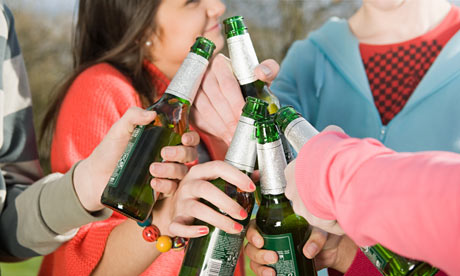
Many teenagers experiment with alcohol and even adults consider it a form of normal youthful rebellion. Unfortunately, however, teenage drinking can quickly get out of control and become life threatening, whether in the form of drinking and driving or through long-term alcohol abuse. How, then, can parents and other concerned adults identify and stop the problem before its too late?
Alcohol use by teens often carries with it some clear behavioral and social signs that may give away your teen’s secret habits. If you spot any of these clues, it’s time to have a serious conversation.
Warning Signs
As an adult who’s most likely imbibed (or even over-imbibed) a few times in your life, you probably know some of the common signs of alcohol use. That’s why you should know better than to ignore increasingly frequent headaches or vomiting spells, sure giveaways of a hangover. Your teen may also have slurred speech, coordination problems, and may also show decreased motivation or a loss of interest in prior hobbies.
Other common signs of alcohol abuse in teens include falling grades, change in friend group, or unusually sneaky behavior. They may avoid eye contact with you or be more inclined to be argumentative. Any of these indicators suggest that your child is doing more than having a single beer with friends, but is struggling with a much deeper problem.
Substance Combinations
In addition to experimenting with alcohol, many teenagers combine drinking with forays into drug use. Currently, the United States is currently in the grip of an opioid epidemic, largely fueled by the misuse of medication. Like alcohol, opioids like Vicodin and OxyContin are things teens may have access to at home through adults or siblings, sneaking pills from the medicine cabinets.
Combining opioids and alcohol is extremely dangerous as both are depressants and can cause slowed respiration, loss of consciousness, and even death. Teens often think it’s okay to take these pills, that they’re safer than “street†drugs because they’re prescribed by doctors, but that isn’t the case.
Another dangerous combination popular with teens is alcohol and caffeine. In this case, we’re looking at a depressant and a stimulant, but that doesn’t mean the two substances somehow cancel each other out. Rather, as the Four Loko craze demonstrated a few years ago, combining alcohol and caffeine comes with unexpected results. Studies suggest that ingesting the two together can cause effects similar to using cocaine. This can cause permanent changes in the developing brain.
Dangers Abound
Between 2002 and 2014, teen alcohol use decreased 6 percent, but that doesn’t mean our young people are out of the clear. Rather, teens who use alcohol are still at a much greater risk of death, whether from drunk driving, poisoning, drowning, or even suicide. In 2011, alcohol-related ER visits among teens constituted 43 percent of all substance use visits.
It’s important to talk to our teens about alcohol use and about our expectations for them. This isn’t about shaming or even banning – we all know that telling teens what they shouldn’t do is likely to incite them to do exactly that thing. Rather, it’s about discussing safety precautions and offering them support. Tell your teens you’ll pick them up if they’ve been drinking, talk about the importance of not combining substances, and assure them you’ll always be there to listen – their future depends on it.